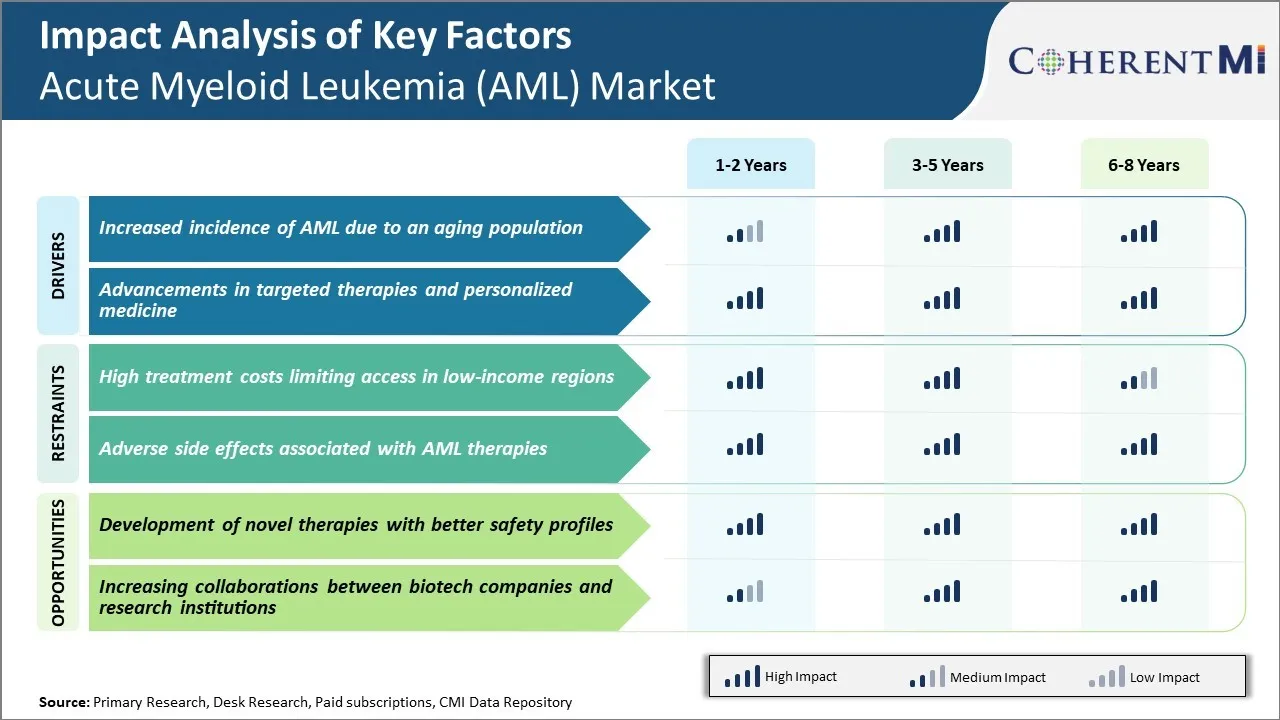Acute Myeloid Leukemia AML Market Trends
Market Driver - Increased Incidence of AML due to an Aging Population
As the population ages worldwide, incidences of acute myeloid leukemia are expected to rise substantially in the coming years. It is a well-established fact that AML affects adults with around 70% of cases being diagnosed in people aged above 65 years.
It is projected that number of people aged 65 years or older globally will double from present levels to over 1.5 billion by 2050. People in this age bracket have considerably higher chances of contracting AML compared to younger individuals. With more of the population entering the high-risk age brackets, absolute numbers of AML cases cannot remain unchanged. Even in developed markets where healthcare systems are well equipped, higher caseload will put pressure on existing resources and infrastructure.
Declining immune system and increased susceptibility to DNA damage can make elderly more prone to blood cancers like AML. Higher prevalence of comorbidities also contributes to poorer outcomes in older patients. While R&D efforts continue for developing safer and more effective treatment options, rising geriatric population alone guarantees rising AML incidence rates in future.
Even if cure rates improve marginally, the anticipated spike in older demographic will outweigh such gains, leading to a net increase in AML patient numbers requiring care.
Market Driver - Advancements in Targeted Therapies and Personalized Medicine
The oncology field has seen transformative research in targeted therapies and precision medicine approaches for blood cancers in last decade. More sophisticated understanding of molecular pathogenesis at genetic level has enabled development of novel treatment regimens tailored to individual patient's disease profile. This shift towards biomarker-driven personalized care holds promising prospects for improving AML management.
With the advent of genomic profiling technologies, clinicians are now able to identify specific genetic mutations and abnormalities driving a patient's leukemia. Based on such molecular insights, targeted drugs blocking critical pathogenetic pathways and proteins can be selected. Several targeted agents attacking mutations in genes like FLT3, IDH1/2, BCL-2 have demonstrated clinically meaningful responses in clinical trials. Other targeted classes under investigation includes tyrosine kinase inhibitors, hypomethylating agents, BCL-2 inhibitors and immunotherapy agents.
Furthermore, adaptive trial designs are being increasingly used to fast-track regulatory approval of new therapies shown to be effective for certain biomarker-defined subsets. This allows quicker access to custom treatments. Combinatorial regimens employing multiple targeted drugs also hold potential to achieve improved remission rates by simultaneously blocking multiple cancer growth pathways. Overall, technological evolution provides much optimism regarding improved outcomes, increased survival times and higher quality of life for AML patients.

Market Challenge - High Treatment Costs Limiting Access in Low-income Regions
At nearly $150,000 per patient in the United States, the high costs of AML treatment pose a significant challenge for access in lower-income regions globally. Most AML drugs require lengthy hospital stays for intensive chemotherapy administration and many patients also require bone marrow transplantation, further increasing costs.
In developing countries and emerging markets, healthcare budgets are much more constrained and standard AML regimens may exceed what public insurance or out-of-pocket payments can support. This creates inequity where patients in wealthy countries have access to the latest drugs while patients elsewhere face worse outcomes due only to financial limitations.
Addressing these access issues through efforts like tiered pricing models or partnerships with global health organizations could help expand availability of novel agents in regions where costs serve as the primary barrier to treatment.
Market Opportunity - Development of Novel Therapies with Better Safety Profiles
There is potential for novel AML therapies to not only improve survival rates but also address some of the challenges associated with existing regimens' adverse side effects and tolerability issues. Areas of exploration include targeted therapies that interfere with specific molecular pathways driving leukemic cells or immunotherapies that harness the body's own immune system.
A promising new class is antibody drug conjugates that home payload anticancer drugs directly to leukemia cells. Development of therapies with enhanced safety profiles could make treatments more suitable for older or sicker patient populations and avoid hospitalizations for chemotherapy administration. This could lower the overall cost of care while broadening the markets accessible to novel agents.